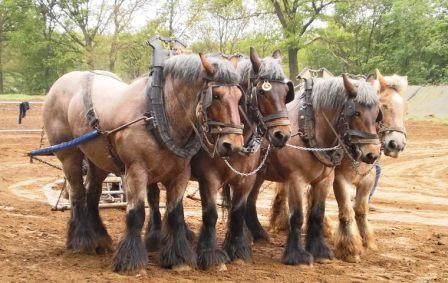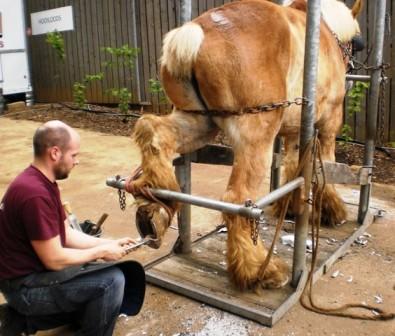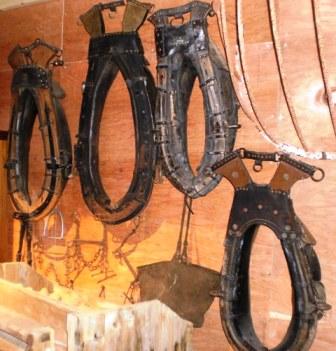"But Francis, you're wrong on the horse!“ “Do you know what direction I want to ride?”(Theo Bergsma)
"There flies a horse! And yet another!“ “There's definitely a nest somewhere! “(Theo Bergsma)
 The horse is a soliped herd animal and can be about thirty years old.
The horse is a soliped herd animal and can be about thirty years old.
At a height of less than 148 cm, we usually talk about ponies. Between 1.47 m and 1.57 m of a small horse (or ladies horse) and at a higher height of a horse.
Horses (Equus caballus) were held as draft and mount for mining, post, cowboys, towing vessels, agriculture, (horses) fisheries, forestry, treadmills (horse mill), recreation and sports and military applications. Nowadays there are also companies that milk horses. A horse can be milked 4 times a day. This produces 4 to 5 liters of milk.
Most manure is used for the cultivation of mushrooms.
With a horse you could cultivate 10 to 12.5 hectares (6 ha of clay, sand 10 ha, 20 ha of pasture). Per ha you need with a horse an hour for harrows, half day clay soil plowing, mowing one and a half hours, pick up hay a day.
Many farmers used oxen because maintenance was cheaper. An ox has half of its tensile strength, a cow a quarter or a 1/3rd.
Sometimes horses got ‘trippen’ or boards under the hoofs not to sink away in loose soil.
At the beginning of our era there were horse sandals: iron foot plates with four upright parts trough which ran straps or buckles to secure them.
 In the wild, horses run on unshod hooves. The horseshoe seems a stopgap measure from the Middle Ages to mask the poor hoof quality caused by poor living conditions and still make the horse useful. Horseshoes were considered necessary as horses had to carry heavy loads and had to walk a lot on paved roads. Nowadays one can find horseshoes unnecessary, unnatural, and even harmful, unless it is to correct incorrect position. However, the hoof must be regularly groomed and trimmed.
In the wild, horses run on unshod hooves. The horseshoe seems a stopgap measure from the Middle Ages to mask the poor hoof quality caused by poor living conditions and still make the horse useful. Horseshoes were considered necessary as horses had to carry heavy loads and had to walk a lot on paved roads. Nowadays one can find horseshoes unnecessary, unnatural, and even harmful, unless it is to correct incorrect position. However, the hoof must be regularly groomed and trimmed.
Horses have 4 bits of lucky nailed to their feet. They should be the luckiest animals in the world.
(Eddie Izzard)
Horse harness and rigging straps are a system of belts and connectors to work with a horse. A halter has no bit (mouthpiece). It has a loop around the nose (between nose and eyes), one behind the ear and jaw. Both of them are in the extension of the lip along both sides connected to each other by a belt or rope. Also reins could possibly occur.
A riding horse also gets usually a saddle, with attached stirrups, and girt.
 In harness horses and draft horses are also taking the reins (long reins) and a breast collar and breast plate. With a chest harness horses pull a load (cart, plow, sleigh, carriage). Instead of a breast collar can also be used a horse collar or a harness. Also girths, crupper, straps and blinkers may belong to the equipment.
In harness horses and draft horses are also taking the reins (long reins) and a breast collar and breast plate. With a chest harness horses pull a load (cart, plow, sleigh, carriage). Instead of a breast collar can also be used a horse collar or a harness. Also girths, crupper, straps and blinkers may belong to the equipment.
The thill are two specially shaped beams or bars between which the horse runs (in a sulky, a cart, charriot).
A collar is a horseshoe-shaped wooden neck part or yoke of a draft animal. In some regions it is called hame. The collar has a more luxurious version for carriages, an other collar for fieldwork. Both are lined with leather and feature hame pillows. A (horse) bridle should be spacious enough, properly distribute the power and above all not obstruct the airway.
There are open, closed and hinged versions. Each saddle maker had his own type (s) and specifications.
Gale (Myrica gale) and (White) Moth Mullein (Verbascum blattaria) were hung on a horse head to keep flies away.
With a rope or simply harness a horse can pull 60 kg. A heavier burden closes down the windpipe. The (padded) harness is a great invention of the Chinese of around the year 500, which after 920 also in Europe brought a revolution in agriculture (plow, sledge, cart) about.
To pull vehicles and agricultural implements oxen are built easily: a straight line for back and neck, with above the shoulder a bump in front of which a pulling rig can be mounted.
A horse does not have that hump and moreover the neck tends upwards. Without natural attachment point for implements. Historically, there are three types of harness made.
The gullet and stomach belt harness has straps from top shoulder around the throat and around the abdomen. The towing point is above the shoulder where the straps meet.
The second type has on the center of each side flank a pulling point, connected to a strap across and in front of the chest, which is delayed by a strap over the shoulder.
The most effective is the horse collar, a padded harness on neck and chest, with strain point above the front legs. This gives the horse artificially a bump that had the ox naturally. It was before the first century use in China, a thousand years earlier than in Europe.
Two horses with the first rig can (experimentally) pull 500 kilograms. A horse with a horse collar can pull one and a half tonnes.
The guidance to mount a horse and prepare consisted first of the moons, later handles on the saddle. Around the third century, the Chinese poured metal stirrups. Before that there were probably already loops in other materials.
To direct a horse there are several types of bits designed: a rod transversely placed in the edentulous posterior part of the mouth of the horse, with to both sides a ring to attach straps. The rod may have a wave (leverage), one or two links... It sounds painful rather than appetizing.
A bitless rig around the nose is called bosal.
Bridles are made of leather straps. And aggressive horses also had a muzzle.
For the comfort of the user, there are several types of saddle, solid, filled cushions upholstered in wooden structures.
"Who works like a horse is an ass.” (Maurice Geeroms)
Says one stallion: "You look strange! ““Sure. Last night I had a nightmare! "
Bronco: from tarpan to Konik and back
Equus ferus is the name for a wild horse. The domesticated horse is called Equus (ferus) caballus.
Tarpan (Equus ferus ferus) was a wild horse that appeared in the steppes of southern Russia. The forest-tarpan (Equus ferus sylvaticus) lived from the Rhine to the east of Poland. The last specimen died in 1887.
The only surviving subspecies of the wild horse is the Przewalski's horse, Equus ferus przewalskii. Most animals were caught and tamed by farmers, and crossed with their domesticated animals. Tarpans were also hunted for meat that was known as a delicacy.
With the tarpan crossbred animals that still have tarpan genes are the Polish “Konik “horses. Konik means “small horse". They are used to breed the tarpan back.
They are small, with a height of about 135 cm. They have relatively long ears and partially upright mane. The coat is mouse gray with a dorsal stripe and zebra stripes on the limbs, without white markings but with a white winter coat (in an arctic climate).
The first back -bred “tarpan“ or Heck horse was a colt that in Tierpark Hellabrunn was born on May 22, 1933 in Munich.
They are robust and can withstand a harsh climate. They are fertile, rarely abort and have a strong immune system. Not too large wounds restore without care. They are very sober and seek their food in the wild. The konik horse is therefore the most widely used for grazing in nature areas.
The forest species of the original European wild horse would be preserved in the now common and for centuries already unchanged Exmoor pony.
In Flemish chip shop is a delicious stew often horse. Regional the cooking is called the 'scoop'.
